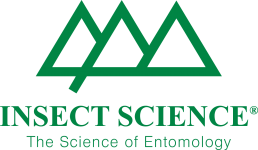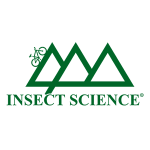IDENTIFICATION
Egg: Greenish to white. Laid in clusters of 30-100 on the lower leaf surface and covered with down, formed from hair and scales from the moth’s body, as illustrated.
Larva: Mature larval size varies from 22-30 mm and colour varies as development progresses. Very young caterpillars are pale green to yellow. During the third instar they acquire pale lateral stripes and the fourth instar is darker dorsally with a dark lateral stripe. During the fifth instar the colour varies greatly. They either retain their dark appearance (illustrated) or are green dorsally and pink or yellow ventrally with a white stripe laterally (illustrated).
A series of spots may be found dorsally and/ or dorsolaterally. Other colour variations may also occur. The body of the caterpillar bears very little hair, resulting in a smooth appearance. The predominant colour of caterpillars is a pale olive green.
Pupa: Mature larvae pupate in the soil.
Adult: The moths (illustrated) are approximately 15 mm long, pale grey or brown with brown to orange markings on each forewing. The hind wings are whiteish with dark veins on the outer edges.
HOST PLANTS
Lesser army worm larvae feed on most vegetables, but they prefer spinach, beet, potato and pea. Apart from vegetables, they also feed on a range of other cultivated crops such as grains, maize, sorghum, millet, lucerne and turf grasses in addition to natural pastures.
DAMAGE
The caterpillars damage plants by chewing large holes into foliage. The first instar larvae feed gregariously while skeletonising leaves. The young caterpillars also tend to spin fine webbing, especially at growth points, under which they hide and feed. When growth points are damaged, plants tend to compensate by producing extra growth. As the larvae grow older, they become solitary and feed alone. Larvae move from plant to plant while feeding, and when overcrowding occurs, they move en masse out of fields, hence the common name (this is seldom observed, however). When fruit are attacked, damage is more severe than when only foliage is consumed, since most plants can tolerate the removal of leaves to some extent. However, some crops, e.g. cabbage, spinach and lettuce can suffer severe damage when attacked by lesser army worms.
The pest status of the lesser army worm depends on the population densities during the season and the age and size of the plants, in which case high numbers on small plants may cause severe yield losses. They are present during most years, but in low numbers. Only when numbers increase in young plantings is a yield loss expected.
LIFE HISTORY
Lesser army worm moths are good fliers and fly long distances to infest distant crops. Young caterpillars tend to spin fine silken threads near their feeding sites, causing young and tender leaves to curl upwards. These curls serve as refuge for the young larvae during the day.
Moths lay up to 600 eggs on lower leaf surfaces, near blossoms and the tips of branches or stems. Like the tomato moth, females cover their eggs with down, giving it a fluffy or cotton wool-like appearance. During warm weather, the eggs hatch in 3-4 days. Larval development time depends on food quality and ambient temperature. During summer, the first instar larvae reach maturity within ten days. Most moths usually emerge within a week during summer and live for about a week. The life cycle lasts 3-4 weeks in summer, but up to four months in cold environments or when larvae feed on unsuitable host plants. There is no overwintering stage.
NATURAL ENEMIES
A wide range of natural enemies is known to attack the eggs, larvae, and pupae of the lesser army worm throughout its disruption range. Records of parasitic wasps from southern Africa include Euplectus laphygmae Ferrière (Eulophidae) and unidentified species of Brachymeria (Chalcididae) and Pteromalus (Pteromalidae). Parasitoids known from elsewhere include species of well-known genera such as Trichogramma (Trichogrammatidae), Telenomus (Scelionidae), Pristomerus (Ichneumonidae) and Chelonus (Braconidae).
MANAGEMENT
Insecticides are available for the control of army worm on various crops. In small plots, scouting can be done to find and destroy caterpillars feeding on foliage. Smaller caterpillars can be found by searching for the thin webbing between leaves and the egg masses can be located and destroyed by searching for fluffy, cotton wool-like deposits on leaves. Most larvae only feed at night; during the day they are found on the lower foliage or under clods of soil near plants. When scouting for larvae, older or dry leaves as well as the soil environment should be inspected.







